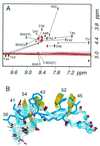Tryptophan zippers: stable, monomeric beta -hairpins
- PMID: 11331745
- PMCID: PMC33255
- DOI: 10.1073/pnas.091100898
Tryptophan zippers: stable, monomeric beta -hairpins
Erratum in
- Proc Natl Acad Sci U S A 2002 Jun 25;99(13):9081
Abstract
A structural motif, the tryptophan zipper (trpzip), greatly stabilizes the beta-hairpin conformation in short peptides. Peptides (12 or 16 aa in length) with four different turn sequences are monomeric and fold cooperatively in water, as has been observed previously for some hairpin peptides. However, the folding free energies of the trpzips exceed substantially those of all previously reported beta-hairpins and even those of some larger designed proteins. NMR structures of three of the trpzip peptides reveal exceptionally well-defined beta-hairpin conformations stabilized by cross-strand pairs of indole rings. The trpzips are the smallest peptides to adopt an unique tertiary fold without requiring metal binding, unusual amino acids, or disulfide crosslinks.
Figures





References
-
- Struthers M D, Cheng R P, Imperiali B. Science. 1996;271:342–345. - PubMed
-
- Dahiyat B I, Sarisky C A, Mayo S L. J Mol Biol. 1997;273:789–796. - PubMed
-
- Dahiyat B I, Mayo S L. Science. 1997;278:82–87. - PubMed
-
- Kortemme T, Ramirez-Alvarado M, Serrano L. Science. 1998;281:253–256. - PubMed
-
- Gellman S H. Curr Opin Chem Biol. 1998;2:717–725. - PubMed
MeSH terms
Substances
Associated data
- Actions
- Actions
- Actions
LinkOut - more resources
Full Text Sources
Other Literature Sources

